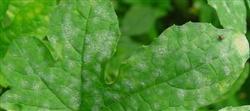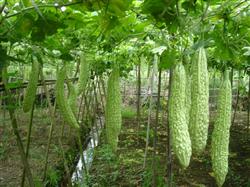How to manage the cultivation of balsam pear in the middle stage?

How to manage the cultivation of balsam pear in the middle stage? Please introduce the management method balsam pear is in the peak period of fruit in the middle period, how to get the maximum harvest in the limited time is the most concerned problem for vegetable farmers. Can refer to the following methods for management: first, topdressing is similar to cucumber, balsam pear likes potash fertilizer. Now that the weather is getting colder and the ground temperature is declining, it is not suitable to apply compound fertilizer so as not to affect the absorptive capacity of the root system. At this time, it is appropriate to choose water-soluble fertilizer with high potassium, biological fertilizer and chitin, which can have the effect of root cultivation, high yield and good coloring. Second, transparent ventilation balsam pear likes light, if the light transmission is not good, it will affect coloring, flowering and pollination. Poor ventilation will increase the chances of bacterial infection. Third, focus on the prevention and control of powdery mildew, and at the same time prevent the leaves from yellowing when anthracnose and downy mildew are serious, seriously affect photosynthesis, reduce the transport of photosynthetic products, and greatly reduce the yield and quality of balsam pear. Must be timely, continuous control, available: sulfur, domicol, rising potential, azoxystrobin, difenoconazole, phenylpropanol and so on. Fourth, the control of virus disease is still based on control, not paying attention to will affect the yield, the key is that it will lead to a decline in appearance quality, so that the price of balsam pear is greatly reduced. Such drugs are: aminooligosaccharins can passivate the virus; Ningnanmycin can control the virus, while mixed with zinc fertilizer spray, it can help to stretch the leaves to increase the photosynthetic area and reduce the harm of the virus. Fifth, timely removal of old and diseased leaves is to reduce the host of bacteria, and second, it is conducive to ventilation and light transmission. It's better than a dose of medicine. Therefore, this work must be done well. Sixth, control root-knot nematodes with 5000 times of 5% Jin Aiwei Ding or 1.8% Baoyin 1500 times, while adding 4% alginic acid or 3% chitin 800-1000 times, not only kill nematodes but also promote rooting. The damage degree of visual nematodes was irrigated three times every 5-7 days. Pay attention to the prevention and control of physiological leaf blight, which is closely related to management, such as excess potassium fertilizer, which will inhibit the absorption of magnesium by plants and cause leaf senescence; because balsam pear likes potassium, timely supplement of magnesium fertilizer has a good effect on delaying leaf senescence. Eighth, supplement boron fertilizer boron is a kind of good prevention and control "flower but not fruit, solid but not fruit" element. Many vegetable farmers still have a prejudice against micro-fertilizer. In fact, plant deficiency is the same as human deficiency. If people are seriously deficient in vitamin E, they will get night blindness, and plant deficiency will also get sick. Foliar fertilizer is very important. Foliar fertilizer should be sprayed once every 7-10 days. Better foliar fertilizers are: Huide nutrient solution can supplement physiological yellow leaves caused by element deficiency, protect flowers and fruits; phosphorus and potassium power (potassium dihydrogen phosphate) can grow strong and increase the weight of single melon; seaweed (alginic acid) can promote flower and fruit protection, enhance resistance, cold resistance and good coloring; chitin can promote root maintenance, increase the number of capillary roots and prolong the harvest time. 10. Pollination is the key to the flowers because of the cold weather, and the temperature in the shed below 15 degrees at night will cause flowering delay or non-flowering, affecting the yield. To sum up, balsam pear management is a relatively tedious process, we must always implement the management policy of "prevention first" in order to continuously improve the yield and quality of balsam pear and obtain a better harvest. Click to get more balsam pear planting techniques click to get more vegetable planting techniques
- Prev

How does balsam pear prevent powdery mildew and virus disease?
Powdery mildew virus disease balsam pear how to prevent powdery mildew and virus disease? Please introduce the prevention and control methods of bitter gourd powdery mildew and virus disease can refer to the following methods: first, powdery mildew: it is easy to get this disease during flowering and fruiting, the leaves are first covered with white powdery matter, gradually making the leaves green and yellowing, leading to premature senescence of the plant.
- Next

How to manage the cultivation of balsam pear in the middle and later stage
How should the cultivation of balsam pear be managed in the middle and later period? Please introduce management methods to cultivate balsam pear in the middle and later stage, we can refer to the following methods for management: first, from the seedling stage, balsam pear should be ploughed, weeded and cultivated in time to prevent soil consolidation. Generally, after planting and watering the seedlings slowly,.
Related
- Where is it suitable to grow horseradish in China? it is expected to see the middle altitude horseradish in Alishan.
- How to prevent tomato virus disease reasonably? (Control methods included)
- Many people like to plant towel gourd on the balcony. What are the main points of this method and management?
- What crops can chili peppers be mixed with?
- Fertilization techniques and matters needing attention in Tomato
- What are the grafting techniques for peach seedlings in spring?
- Harm and control methods of root swelling disease of Chinese cabbage
- What are the pests of sweet potatoes? How to prevent and cure it?
- Symptoms, causes and Control methods of navel Rot in Tomato
- The cause of "Cucumber rotten bibcock" in Farmers' planting Cucumber and its Control Plan

